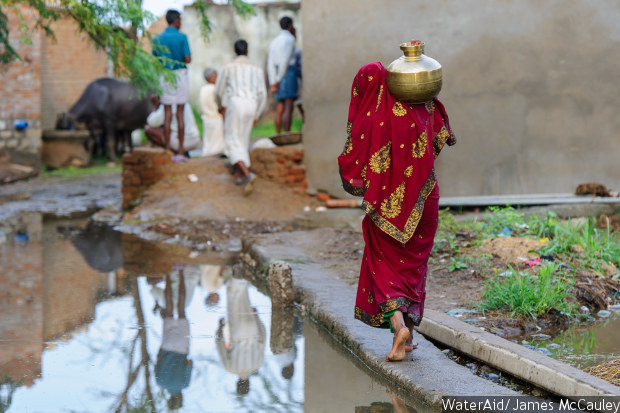63 Million Indians Without Clean Drinking Water = Population Of Australia+Sweden+Sri Lanka+Bulgaria
A woman collects water in the village of Narai Ka Pura, in Morena district, Madhya Pradesh. As much as 67% of India’s population lives in rural areas and 7% of its rural population is living without access to clean water
India has more people in rural areas--63.4 million--living without access to clean water than any other country, according to Wild Water, State of the World’s Water 2017, new report by WaterAid, a global advocacy group on water and sanitation.
That is more than the combined population of Punjab, Haryana and Uttarakhand. Compared globally, that is as many people as live in Australia, Sweden, Sri Lanka and Bulgaria--combined.
“With 27 out of 35 states and union territories in India disaster-prone, the poorest and the most marginalised will bear the brunt of extreme weather events and climate change and will find it the hardest to adapt,” said V K Madhavan, chief executive , Water Aid India.
With 67% of India’s population living in rural areas and 7% of the rural population living without access to clean water, India’s rural poor are highly vulnerable to the effects of extreme weather events and climate change.
The report was released to mark the World Water Day on March 22, and it warns of the implications that extreme weather events and climate change may have for the world’s poorest people.
16% of India’s rural families have piped water
Only 26.9 million out of 167.8 million households (16%) in rural India have piped water, according to data provided by the ministry of drinking water and sanitation to the Rajya Sabha (upper house of Parliament) on February 6, 2017.
Of 1.7 million rural habitations provided drinking water under the National Rural Drinking Water Programme, 1.3 million (77%) habitations are fully covered--defined as having at least 40 litres per capita per day (LPCD)--that is nearly two standard buckets--of safe water; 330,086 (19.3%) habitations are partially covered (safe water is available but below 40 LPCD) and 64,094 (3.73%) are “water-quality affected habitations”--meaning those with contaminated water--in the rural areas as on March 15, 2017, according to this answer to the Rajya Sabha on March 20, 2017.
Source: Lok Sabha (As of March 2017)
Iron, which is known to cause respiratory system haemorrhage when mixed with drinking water, according to the World Health Organization, was found in water supplied to 30% or 19,720 rural Indian habitations, according to an answer to the Lok Sabha on March 16, 2017.
Arsenic, known to cause skin lesions and cancer, was found in the drinking water source of 21% of such habitations.
The goal: piped water for 90% of rural households by 2022
The government plans to provide 50% of all rural households with piped water and 35% of rural households with household taps by the end of 2017, according to the strategic plan for rural drinking water, 2011-2022.
The goal is to provide 90% rural households with piped water and 80% of rural households with household taps by 2022.
Water availability per capita has been declining in India due to the increase in population.
The average annual per capita water availability in 2001 and 2011 was assessed at 1,820 cubic metre (m3) and 1,545 m3, respectively. Over this period, India’s population rose 17.6%, from 1.02 billion to 1.21 billion. The water available may decline to 1,341 m3 and 1,140 m3 by 2025 and 2050, respectively, according to this 2013 report by the ministry of environment and climate change, indicating the widening gap between demand and availability of water.
Scanty rain directly affects water availability. Water levels at 91 major reservoirs were at the lowest in a decade to 2016 because of a nationwide drought, IndiaSpend reported on March 22, 2016.
“With the per capita availability of water continuing to decline, the nation hurtles towards water scarcity,” the environment ministry’s report said. “Climate change, which might bring in its wake increased temporal and spatial variation in availability of water, is likely to exacerbate the water situation.”
“Along with access to safe water, it is critical that communities have the necessary tools, infrastructure and preparedness to deal with the effects of extreme weather events and climate change,” said Water Aid’s Madhavan.
(Salve is an analyst with IndiaSpend.)
We welcome feedback. Please write to respond@indiaspend.org. We reserve the right to edit responses for language and grammar.
__________________________________________________________________
“Liked this story? Indiaspend.org is a non-profit, and we depend on readers like you to drive our public-interest journalism efforts. Donate Rs 500; Rs 1,000, Rs 2,000.”



